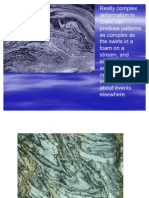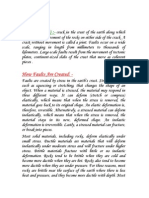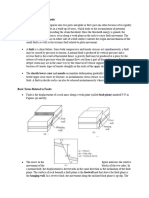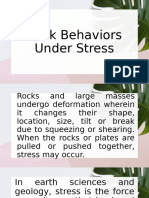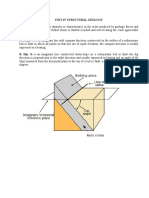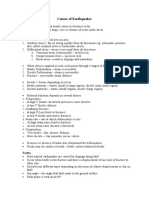Earth Quake
Earth Quake
Uploaded by
Joseph ZotooCopyright:
Available Formats
Earth Quake
Earth Quake
Uploaded by
Joseph ZotooOriginal Description:
Copyright
Available Formats
Share this document
Did you find this document useful?
Is this content inappropriate?
Copyright:
Available Formats
Earth Quake
Earth Quake
Uploaded by
Joseph ZotooCopyright:
Available Formats
EQ: Causes and Measurements
EENS 3050 Tulane University
Natural Disasters Prof. Stephen A. Nelson
Earthquakes: Causes and Measurements
This page last updated on 02-Jul-2012
Earthquakes The objectives of this part of the course will to be gain an understanding of the science of earthquakes so that we can answer the following questions: 1. 2. 3. 4. 5. 6. What causes earthquakes? How are earthquakes studied? What happens during an earthquake? Where do earthquakes occur? Can earthquakes be predicted? Can humans be protected from earthquakes?
Most earthquakes occur along zones where the Earth's crust is undergoing deformation. Deformation results from plate tectonic forces and gravitational forces. The type of deformation that takes place during an earthquake generally occurs along zones where rocks fracture to produce faults. Before we can understand earthquakes, we first must explore deformation of rocks and faulting. Within the Earth rocks are constantly subjected to forces that tend to bend, twist, or fracture them. When rocks bend, twist or fracture they are said to deform or strain (change shape or size). The forces that cause deformation are referred to as stresses. To understand rock deformation we must first explore stress and strain. Stress and Strain Stress is a force applied over an area. One type of stress that we are all used to is a uniform stress, called pressure. A uniform stress is where the forces act equally from all directions. In the Earth the pressure due to the weight of overlying rocks is a uniform stress and is referred to as confining stress. If stress is not equal from all directions then the stress is a differential stress. Three kinds of differential stress occur. 1. Tensional stress (or extensional stress), which stretches rock; 2. Compressional stress, which squeezes rock; and 3. Shear stress, which result in slippage and translation.
Page 1 of 16
7/2/2012
EQ: Causes and Measurements
Stages of Deformation When a rock is subjected to increasing stress it changes its shape, size or volume. Such a change in shape, size or volume is referred to as strain. When stress is applied to rock, the rock passes through 3 successive stages of deformation.
�
Elastic Deformation -- wherein the strain is reversible. Ductile Deformation -- wherein the strain is irreversible. Fracture -- irreversible strain wherein the material breaks.
We can divide materials into two classes that depend on their relative behavior under stress.
�
Brittle materials have a small to large region of elastic behavior, but only a small region of ductile behavior before they fracture. Ductile materials have a small region of elastic behavior and a large region of ductile behavior before they fracture.
Page 2 of 16
7/2/2012
EQ: Causes and Measurements
How a material behaves will depend on several factors. Among them are:
�
Temperature - At high temperature molecules and their bonds can stretch and move, thus materials will behave in more ductile manner. At low Temperature, materials are brittle. Confining Pressure - At high confining pressure materials are less likely to fracture because the pressure of the surroundings tends to hinder the formation of fractures. At low confining stress, material will be brittle and tend to fracture sooner. Strain rate -- Strain rate refers to the rate at which the deformation occurs (strain divided by time). At high strain rates material tends to fracture. At low strain rates more time is available for individual atoms to move and therefore ductile behavior is favored. Composition -- Some minerals, like quartz, olivine, and feldspars are very brittle. Others, like clay minerals, micas, and calcite are more ductile This is due to the chemical bond types that hold them together. Thus, the mineralogical composition of the rock will be a factor in determining the deformational behavior of the rock. Another aspect is presence or absence of water. Water appears to weaken the chemical bonds and forms films around mineral grains along which slippage can take place. Thus wet rock tends to behave in ductile manner, while dry rocks tend to behave in brittle manner.
Evidence of Former Deformation Evidence of deformation that has occurred in the past is very evident in crustal rocks. For example, sedimentary layers and lava flows generally are deposited on a surface parallel to the Earth's surface (nearly horizontal). Thus, when we see such layers inclined instead of horizontal, evidence of an episode of deformation is present. In order to uniquely define the orientation of a planar feature we first need to define two terms strike and dip. For an inclined plane the strike is the compass direction of any horizontal line on the plane. The dip is the angle between a horizontal plane and the inclined plane, measured perpendicular to the direction of strike.
Page 3 of 16
7/2/2012
EQ: Causes and Measurements
In recording strike and dip measurements on a geologic map, a symbol is used that has a long line oriented parallel to the compass direction of the strike. A short tick mark is placed in the center of the line on the side to which the inclined plane dips, and the angle of dip is recorded next to the strike and dip symbol. For beds with a 90o dip (vertical) the short line crosses the strike line, and for beds with no dip (horizontal) a circle with a cross inside is used.
Fracture of Brittle Rocks Joints Joints are fractures in rock that show no slippage or offset along the fracture. Joints are usually planar features, so their orientation can be described as a strike and dip. They form from as a result of extensional stress acting on brittle rock. Such stresses can be induced by cooling of rock (volume decreases as temperature decreases) or by relief of pressure as rock is eroded above thus removing weight. Joints are zones of weakness,so their presence is critical when building anything from dams to highways. For dams, the water could leak out through the joints leading to dam failure. For highways the joints may separate and cause rock falls and landslides. Faults - Faults occur when brittle rocks fracture and there is an offset along the fracture. When the offset is small, the displacement can be easily measured, but sometimes the displacement is so large that it is difficult to measure.
Page 4 of 16
7/2/2012
EQ: Causes and Measurements
Types of Faults Faults can be divided into several different types depending on the direction of relative displacement. Since faults are planar features, the concept of strike and dip also applies, and thus the strike and dip of a fault plane can be measured. One division of faults is between dipslip faults, where the displacement is measured along the dip direction of the fault, and strikeslip faults where the displacement is horizontal, parallel to the strike of the fault.
�
Dip Slip Faults - Dip slip faults are faults that have an inclined fault plane and along which the relative displacement or offset has occurred along the dip direction. Note that in looking at the displacement on any fault we don't know which side actually moved or if both sides moved, all we can determine is the relative sense of motion. For any inclined fault plane we define the block above the fault as the hanging wall block and the block below the fault as the footwall block.
�
Normal Faults - are faults that result from horizontal tensional stresses in brittle rocks and where the hangingwall block has moved down relative to the footwall block. Horsts & Grabens - Due to the tensional stress responsible for normal faults, they often occur in a series, with adjacent faults dipping in opposite directions. In such a case the down-dropped blocks form grabens and the uplifted blocks form horsts. In areas where tensional stress has recently affected the crust, the grabens may form rift valleys and the uplifted horst blocks may form linear mountain ranges. The East African Rift Valley is an example of an area where continental extension has created such a rift. The basin and range province of the western U.S. (Nevada, Utah, and Idaho) is also an area that has recently undergone crustal extension. In the basin and range, the basins are elongated grabens that now form valleys, and the ranges are uplifted horst blocks.
Page 5 of 16
7/2/2012
EQ: Causes and Measurements
Reverse Faults - are faults that result from horizontal compressional stresses in brittle rocks, where the hanging-wall block has moved up relative the footwall block.
A Thrust Fault is a special case of a reverse fault where the dip of the fault is less than 45o. Thrust faults can have considerable displacement, measuring hundreds of kilometers, and can result in older strata overlying younger strata.
�
Strike Slip Faults - are faults where the relative motion on the fault has taken place along a horizontal direction. Such faults result from shear stresses acting in the crust. Strike slip faults can be of two varieties, depending on the sense of displacement. To an observer standing on one side of the fault and looking across the fault, if the block on the other side has moved to the left, we say that the fault is a left-lateral strike-slip fault. If the block on the other side has moved to the right, we say that the fault is a right-lateral strike-slip fault. The famous San Andreas Fault in California is an example of a right-lateral strike-slip fault. Displacements on the San Andreas fault are estimated at over 600 km.
Transform-Faults are a special class of strike-slip faults. These are plate boundaries along which two plates slide past one another in a horizontal manner. The most common type of transform faults occur where oceanic ridges are offset. Note that the transform fault only occurs between the two segments of the ridge. Outside of this area there is no relative movement because blocks are moving in the same direction. These areas are called fracture zones. The San Andreas fault in California is also a transform fault.
Page 6 of 16
7/2/2012
EQ: Causes and Measurements
Blind Faults - are faults that does not break the surface - rocks above the fault have behaved in ductile fashion and folded over the tip of the fault.
Active Faults- An active fault is one that has shown recent displacement and likely has the potential to produce earthquakes. Since faulting is part of the deformation process, ancient faults can be found anywhere that deformation has taken place in the past. Thus, not every fault one sees is necessarily an active fault. Surface Expression of Faults - Where faults have broken the surface they are shown on maps as fault lines or fault zones. Recent ruptures of dip slip faults at the surface show a cliff that is called a fault scarp. Strike slip faults result in features like linear valleys, offset surface features (roads, stream channels, fences, etc.) or elongated ridges How Faults Develop - When tectonic forces generate stress, rocks start to deform elastically. Eventually small cracks to form along the fault zone. When rupture occurs, the stored elastic energy is released as seismic waves.
Page 7 of 16
7/2/2012
EQ: Causes and Measurements
Earthquakes Earthquakes occur when energy stored in elastically strained rocks is suddenly released. This release of energy causes intense ground shaking in the area near the source of the earthquake and sends waves of elastic energy, called seismic waves, throughout the Earth. Earthquakes can be generated by bomb blasts, volcanic eruptions, and sudden slippage along faults. Earthquakes are definitely a geologic hazard for those living in earthquake prone areas, but the seismic waves generated by earthquakes are invaluable for studying the interior of the Earth. Origin of Earthquakes Most natural earthquakes are caused by sudden slippage along a fault zone. The elastic rebound theory suggests that if slippage along a fault is hindered such that elastic strain energy builds up in the deforming rocks on either side of the fault, when the slippage does occur, the energy released causes an earthquake. This theory was discovered by making measurements at a number of points across a fault. Prior to an earthquake it was noted that the rocks adjacent to the fault were bending. These bends disappeared after an earthquake suggesting that the energy stored in bending the rocks was suddenly released during the earthquake. Friction between the blocks then keeps the fault from moving again until enough strain has accumulated to overcome the friction and generate another earthquake. Once a fault forms, it becomes a zone of weakness - so long as the tectonic stresses continue to be present more earthquakes are likely to occur on the fault. Thus faults move in spurts and this behavior is referred to as Stick Slip. If there is large displacement during an earthquake, a large earthquake will be generated. Smaller displacements generate smaller earthquakes. Note that even for small displacements of only a millimeter per year, after 1 million years, the fault will accumulate 1 km of displacement. Fault Creep - Some faults or parts of faults move continuously without generating earthquakes. This could occur if there is little friction on the fault & tectonic stresses are large enough to move the blocks in opposite directions. This is called fault creep. If creep is occurring on one part of a fault, it is likely causing strain to build on other parts of the fault. Seismology, The Study of Earthquakes When an earthquake occurs, the elastic energy is released sending out vibrations that travel throughout the Earth. These vibrations are called seismic waves. The study of how seismic waves behave in the Earth is called seismology.
Page 8 of 16
7/2/2012
EQ: Causes and Measurements
The source of an earthquake is called the focus, which is an exact location within the Earth were seismic waves are generated by sudden release of stored elastic energy. The epicenter is the point on the surface of the Earth directly above the focus. Sometimes the media get these two terms confused.
Seismic waves emanating from the focus can travel in several ways, and thus there are several different kinds of seismic waves.
�
Body Waves - emanate from the focus and travel in all directions through the body of the Earth. There are two types of body waves: P -waves and S-waves:
P - waves - are Primary waves. They travel with a velocity that depends on the elastic properties of the rock through which they travel.
Where, Vp is the velocity of the P-wave, K is the incompressibility of the
material, is the rigidity of the material, and is the density of the material.
P-waves are the same thing as sound waves. They move through the material by compressing it, but after it has been compressed it expands, so that the wave moves by compressing and expanding the material as it travels. Thus the velocity of the P-wave depends on how easily the material can be compressed (the incompressibility), how rigid the material is (the rigidity), and the density of the material. P-waves have the highest velocity of all seismic waves and thus will reach all seismographs first.
�
S-Waves - Secondary waves, also called shear waves. They travel with a velocity that depends only on the rigidity and density of the material through which they travel:
Page 9 of 16
7/2/2012
EQ: Causes and Measurements
S-waves travel through material by shearing it or changing its shape in the direction perpendicular to the direction of travel. The resistance to shearing of a material is the property called the rigidity. It is notable that liquids have no rigidity, so that the velocity of an S-wave is zero in a liquid. (This point will become important later). Note that S-waves travel slower than P-waves, so they will reach a seismograph after the P-wave.
�
Surface Waves - Surface waves differ from body waves in that they do not travel through the Earth, but instead travel along paths nearly parallel to the surface of the Earth. Surface waves behave like S-waves in that they cause up and down and side to side movement as they pass, but they travel slower than S-waves and do not travel through the body of the Earth. Surface waves are often the cause of the most intense ground motion during an earthquake.
Seismometers Seismic waves travel through the Earth as vibrations. A seismometer is an instrument used to record these vibrations, and the resulting graph that shows the vibrations is called a seismogram. The seismometer must be able to move with the vibrations, yet part of it must remain nearly stationary. This is accomplished by isolating the recording device (like a pen) from the rest of the Earth using the principal of inertia. For example, if the pen is attached to a large mass suspended by a wire, the large mass moves less than the paper which is attached to the Earth, and on which the record of the vibrations is made. Modern instruments are digital and dont require the paper.
The record of an earthquake, a seismogram, as recorded by a seismometer, will be a plot of vibrations versus time. On the seismograph, time is marked at regular intervals, so that we can determine the time of arrival of the first P-wave and the time of arrival of the first S-wave. (Note again, that because P-waves have a higher velocity than S-waves, the Pwaves arrive at the seismographic station before the S-waves)
Page 10 of 16
7/2/2012
EQ: Causes and Measurements
Locating the Epicenters of Earthquakes - To determine the location of an earthquake epicenter, we need to have recorded a seismograph of the earthquake from at least three seismographic stations at different distances from the epicenter. In addition, we need one further piece of information - that is the time it takes for P-waves and S-waves to travel through the Earth and arrive at a seismographic station. Such information has been collected over the last 80 or so years, and is available as travel time curves. From the seismographs at each station one determines the S-P interval (the difference in the time of arrival of the first S-wave and the time of arrival of the first P-wave. Note that on the travel time curves, the S-P interval increases with increasing distance from the epicenter.
Thus the S-P interval tells us the distance to the epicenter from the seismographic station where the earthquake was recorded. Thus at each station we can draw a circle on a map that has a radius equal to the distance from the epicenter. Three such circles will intersect in a point that locates the epicenter of the earthquake.
Page 11 of 16
7/2/2012
EQ: Causes and Measurements
Magnitude of Earthquakes - Whenever a large destructive earthquake occurs in the world the press immediately wants to know where the earthquake occurred and how big the earthquake was (in California the question is usually - Was this the Big One?). The size of an earthquake is usually given in terms of a scale called the Richter Magnitude. Richter Magnitude is a scale of earthquake size developed by a seismologist named Charles Richter. The Richter Magnitude involves measuring the amplitude (height) of the largest recorded wave at a specific distance from the earthquake. While it is correct to say that for each increase in 1 in the Richter Magnitude, there is a tenfold increase in amplitude of the wave, it is incorrect to say that each increase of 1 in Richter Magnitude represents a tenfold increase in the size of the Earthquake (as is commonly incorrectly stated by the press). � A better measure of the size of an earthquake is the amount of energy released by the earthquake. While this is much more difficult to determine, Richter gave a means by which the amount of energy released can be estimated: Log E = 11.8 + 1.5 M Where Log refers to the logarithm to the base 10, E is the energy released in ergs, and M is the Richter Magnitude. Anyone with a hand calculator can solve this equation by plugging in various values of M (magnitude) and solving for E, the energy released. I've done the
Page 12 of 16
7/2/2012
EQ: Causes and Measurements
calculation for you in the following table: Magnitude 1 2 3 4 5 6 7 8 Energy (ergs) 2.0 x 1013 6.3 x 10
14
Factor 31 x
2.0 x 1016 6.3 x 1017 2.0 x 1019 6.3 x 1020 2.0 x 1022 6.3 x 1023
31 x
31 x
31 x
From these calculations you can see that each increase in 1 in Magnitude represents a 31 fold increase in the amount of energy released. Thus, a magnitude 7 earthquake releases 31 times more energy than a magnitude 6 earthquake. A magnitude 8 earthquake releases 31 x 31 or 961 times as much energy as a magnitude 6 earthquake.
�
Although the Richter Magnitude is the scale most commonly reported when referring to the size of an earthquake, it has been found that for larger earthquakes a more accurate measurement of size is the moment magnitude, Mw. The moment magnitude is a measure of the amount of strain energy released by the earthquake as determined by measurements of the shear strength of the rock and the area of the rupture surface that slipped during the earthquake. Note that it usually takes more than one seismographic station to calculate the magnitude of an earthquake. Thus you will hear initial estimates of earthquake magnitude immediately after an earthquake and a final assigned magnitude for the same earthquake that may differ from initial estimates, but is assigned after seismologists have had time to evaluate the data from numerous seismographic stations. The moment magnitude for large earthquakes is usually greater than the Richter magnitude for the same earthquake. For example the Richter magnitude for the 1964 Alaska earthquake is usually reported as 8.6, whereas the moment magnitude for this earthquake is calculated at 9.2. The largest earthquake ever recorded was in Chile in 1960 with a moment magnitude of 9.5, The Summatra earthquake of 2004 had a moment magnitude of 9.0. Sometimes a magnitude is reported for an earthquake and no specification is given as to which magnitude (Richter or moment) is reported. This obviously can cause confusion. But, within the last few years, the tendency has been to report the moment magnitude rather
Page 13 of 16
7/2/2012
EQ: Causes and Measurements
than the Richter magnitude.
�
The Hiroshima atomic bomb released an amount of energy equivalent to a moment magnitude 6 earthquake. Note that magnitude scales are open ended with no maximum or minimum. The largest earthquakes are probably limited by rock strength. Meteorite impacts could cause larger earthquakes than have ever been observed. Frequency of Earthquakes of Different Magnitude Worldwide Magnitude > 8.5 8.0 - 8.4 7.5 - 7.9 7.0 - 7.4 6.6 - 6.9 6.0 - 6.5 5.0 - 5.9 4.0 - 4.9 3.0 - 3.9 2.0 - 2.9 0 - 1.9 Number of Earthquakes per Year 0.3 1 3 15 56 210 800 6,200 49,000 300,000 700,000 Description Great
Major Destructive Damaging
Minor
Modified Mercalli Intensity Scale Note that the Richter magnitude scale results in one number for the size of the earthquake. Maximum ground shaking will occur only in the area of the epicenter of the earthquake, but the earthquake may be felt over a much larger area. The Modified Mercalli Scale was developed in the late 1800s to assess the intensity of ground shaking and building damage over large areas.
�
The scale is applied after the earthquake by conducting surveys of people's response to the intensity of ground shaking and destruction. Thus, a given earthquake will have zones of different intensity all surrounding a zone of maximum intensity. The Modified Mercalli Scale is shown in the table below. Note that correspondence between maximum intensity and Richter Scale magnitude only applies in the area around the epicenter. Thus, a given earthquake will have zones of different intensity all surrounding a zone of maximum intensity. The Modified Mercalli Scale is shown in the table below. Note that correspondence
Page 14 of 16
7/2/2012
EQ: Causes and Measurements
between maximum intensity and Richter Scale magnitude only applies in the area around the epicenter. Intensity Characteristic Effects
Richter Scale Equivalent <3.4
I II III IV
People do not feel any Earth movement A few people notice movement if at rest and/or on upper floors of tall buildings People indoors feel movement. Hanging objects swing back and forth. People outdoors might not realize that an earthquake is occurring People indoors feel movement. Hanging objects swing. Dishes, windows, and doors rattle. Feels like a heavy truck hitting walls. Some people outdoors may feel movement. Parked cars rock. Almost everyone feels movement. Sleeping people are awakened. Doors swing open/close. Dishes break. Small objects move or are turned over. Trees shake. Liquids spill from open containers Everyone feels movement. People have trouble walking. Objects fall from shelves. Pictures fall off walls. Furniture moves. Plaster in walls may crack. Trees and bushes shake. Damage slight in poorly built buildings. People have difficulty standing. Drivers feel cars shaking. Furniture breaks. Loose bricks fall from buildings. Damage slight to moderate in well-built buildings; considerable in poorly built buildings. Drivers have trouble steering. Houses not bolted down shift on foundations. Towers & chimneys twist and fall. Well-built buildings suffer slight damage. Poorly built structures severely damaged. Tree branches break. Hillsides crack if ground is wet. Water levels in wells change. Well-built buildings suffer considerable damage. Houses not bolted down move off foundations. Some underground pipes broken. Ground cracks. Serious damage to Reservoirs. Most buildings & their foundations destroyed. Some bridges destroyed. Dams damaged. Large landslides occur. Water thrown on the banks of canals, rivers, lakes. Ground cracks in large areas. Railroad tracks bent slightly. Most buildings collapse. Some bridges destroyed. Large cracks appear in the ground. Underground pipelines destroyed. Railroad tracks badly bent. Almost everything is destroyed. Objects thrown into the air. Ground moves in waves or ripples. Large amounts of rock may move.
�
4.2 4.3 - 4.8
4.9-5.4
VI
5.5 - 6.1
VII
5.5 - 6.1
VIII
6.2 - 6.9
IX
6.2 - 6.9
7.0 - 7.3
XI XII
7.4 - 7.9 >8.0
The Mercalli Scale is very useful in examining the effects of an earthquake over a large area, because it will is responsive not only to the size of the earthquake as measured by the Richter scale for areas near the epicenter, but will also show the effects of the efficiency that seismic waves are transmitted through different types of material near the Earth's surface. The Mercalli Scale is also useful for determining the size of earthquakes that occurred
Page 15 of 16
7/2/2012
EQ: Causes and Measurements
before the modern seismographic network was available (before there were seismographic stations, it was not possible to assign a Richter Magnitude). Examples of questions on this material that could be asked on an exam 1. Define the following terms (a), stress (b) confining stress, (c) differential stress, (d) tensional stress (e) compressional stress, (e) strain. 2. What are the three stages of deformation that all materials go through as stress is increased? 3. What is the difference between a brittle material and a ductile material? 4. Explain the following types of faults: (a) normal fault, (b) reverse fault, (c) thrust fault, (d) strike-slip fault, and (e) transform fault. 5. Explain the elastic rebound theory on the cause earthquakes. 6. What is the difference between the epicenter of an earthquake and the focus of an earthquake. 7. What are seismic waves and what is the difference between a P-wave, an S-wave and a Surface wave? 8. For each increase of magnitude by a factor of 1, how much more energy is released? 9. What is the difference between Richter magnitude and Moment magnitude and which of these scales is a more accurate measure of the energy released by large earthquakes? 10. What is the difference between the magnitude scale and the Modified Mercalli Intensity Scale? References Return to EENS 3050 Homepage
Page 16 of 16
7/2/2012
You might also like
- Introduction To Resource AnalysisDocument13 pagesIntroduction To Resource AnalysisJoseph Zotoo100% (6)
- Introduction To ClimatologyDocument14 pagesIntroduction To ClimatologyJoseph Zotoo100% (4)
- Long Test 1 - Grade 8Document2 pagesLong Test 1 - Grade 8katherine corvera100% (6)
- Earthquake Causes and MeasurementsDocument16 pagesEarthquake Causes and MeasurementsMahfuzul HaqueNo ratings yet
- Report in ElsDocument2 pagesReport in ElsRowe AlmonteNo ratings yet
- Deformation of Rock: Stress and StrainDocument13 pagesDeformation of Rock: Stress and Strainaprillia frinandaNo ratings yet
- Deformation: Stress and StrainDocument12 pagesDeformation: Stress and StrainDean Putra IdriawadiNo ratings yet
- Rock Deformation: Stress and StrainDocument16 pagesRock Deformation: Stress and StrainSamantha BautistaNo ratings yet
- Landforming ProcessesDocument37 pagesLandforming ProcessesHari OmNo ratings yet
- MechanicalDocument10 pagesMechanicalMohamed MagedNo ratings yet
- Folds and FaultsDocument31 pagesFolds and FaultsDeepesh KhandelwalNo ratings yet
- Group 6 Geological StructuresDocument50 pagesGroup 6 Geological StructuresAlexa Francoise Arao TanoNo ratings yet
- Structural Geology GroundwaterDocument109 pagesStructural Geology Groundwaterkiran_ran99No ratings yet
- Diplom QuestionsDocument62 pagesDiplom QuestionsNarmina MamedovaNo ratings yet
- Rock DeformationDocument23 pagesRock DeformationAlexander Concepcion100% (1)
- Structure GeologyDocument51 pagesStructure Geologyusama_veronNo ratings yet
- Bijay Sen, Reg-24260402005Document15 pagesBijay Sen, Reg-24260402005imavinash221No ratings yet
- FaultDocument5 pagesFaultapi-3808551100% (1)
- Earth Sci 7Document13 pagesEarth Sci 7Cyrus GabutenNo ratings yet
- Different Types of FaultsDocument21 pagesDifferent Types of FaultsJessa Mae GastarNo ratings yet
- Els Week 5 Folding and FaultingDocument37 pagesEls Week 5 Folding and FaultingcloudisaacbulabogNo ratings yet
- GeoEng - JD HendersonDocument4 pagesGeoEng - JD HendersonARIANNE JADE ORBISTANo ratings yet
- The Formation Earth LifeDocument32 pagesThe Formation Earth LifeAngel EstremosNo ratings yet
- Deforming Earth's Crust: Section 3Document12 pagesDeforming Earth's Crust: Section 3Argeena Agao-AgaoNo ratings yet
- In CoalitionDocument8 pagesIn CoalitionIvanovich PimenovaNo ratings yet
- Lesson 2 - ELSDocument50 pagesLesson 2 - ELSalshawy0909No ratings yet
- Types of Geological Stress - StemDocument20 pagesTypes of Geological Stress - StemShekhainah RosalNo ratings yet
- Quiz Es 1029Document31 pagesQuiz Es 1029ERLYN NANGITNo ratings yet
- Rock Stress: How Rocks Behave Under Different Types of Stress Such As Compression, Pulling Apart and ShearingDocument21 pagesRock Stress: How Rocks Behave Under Different Types of Stress Such As Compression, Pulling Apart and ShearingRhone Christian Narciso SalcedoNo ratings yet
- EsciDocument5 pagesEsciemNo ratings yet
- Deformationofthecrust 230330145954 66133a91Document28 pagesDeformationofthecrust 230330145954 66133a91Shekhainah RosalNo ratings yet
- Rock Deformation and Earthquake FinalDocument131 pagesRock Deformation and Earthquake Finalniaz ahmedNo ratings yet
- 5 - Folds, Faults & UnconformityDocument30 pages5 - Folds, Faults & Unconformitymoorpvr100% (1)
- Geological Structures: Today We Will Consider The Structures in Rocks Produced by DeformationDocument44 pagesGeological Structures: Today We Will Consider The Structures in Rocks Produced by DeformationSelly Mutiara RestikaNo ratings yet
- Ol. 8 Continued.Document31 pagesOl. 8 Continued.Salman Bin TariqNo ratings yet
- Overview of Structural Geology and Geologic Map Interpretation PDFDocument26 pagesOverview of Structural Geology and Geologic Map Interpretation PDFMahmoud Eloribi100% (1)
- 5.structural GeologyDocument46 pages5.structural Geologysamir bardewaNo ratings yet
- Rock Behaviors Under Stress - Group5Document16 pagesRock Behaviors Under Stress - Group5SkY HoTdOgNo ratings yet
- Tensional Tectonic PlatesDocument6 pagesTensional Tectonic PlatesRODJHEN ANNE P. BARQUILLANo ratings yet
- ExportDocument-5 AshxDocument21 pagesExportDocument-5 AshxnonolashariNo ratings yet
- CH 2 Sec 1: Forces in Earth's Crust: Guide For ReadingDocument3 pagesCH 2 Sec 1: Forces in Earth's Crust: Guide For ReadingOper SamaniegoNo ratings yet
- Structural Geology Group 5Document35 pagesStructural Geology Group 5richethan25No ratings yet
- Lesson 2.7 The Formation of Faults and FoldsDocument7 pagesLesson 2.7 The Formation of Faults and FoldsJessa Sumayang100% (1)
- CIVE 1207 Lect4 newDocument38 pagesCIVE 1207 Lect4 newMohamedNo ratings yet
- Q2 Module5 Rock Stress LectureDocument26 pagesQ2 Module5 Rock Stress LectureAliki Mae GuardianoNo ratings yet
- Unit IV STRUCTURAL GEOLOGYDocument16 pagesUnit IV STRUCTURAL GEOLOGYRubel RanaNo ratings yet
- Department of Studies in Earth ScienceDocument14 pagesDepartment of Studies in Earth SciencebhumiNo ratings yet
- ES Asynch 10.24.24Document4 pagesES Asynch 10.24.24Crystal Mae QuintoNo ratings yet
- Lecture 4 GEOLOGYDocument10 pagesLecture 4 GEOLOGYnattydreadfathelahNo ratings yet
- Kuliah Struktur GeologiDocument75 pagesKuliah Struktur GeologiAshabul KahfiNo ratings yet
- Stress Faults and FoldsDocument21 pagesStress Faults and FoldsReliza Amahan SenoNo ratings yet
- Stress Faults and FoldsDocument21 pagesStress Faults and FoldsmnemoxeneNo ratings yet
- Chapter 7Document6 pagesChapter 7fqyh2s9vcjNo ratings yet
- Causes of EarthquakesDocument2 pagesCauses of EarthquakesPyae PhyoNo ratings yet
- Science 10 Q1 L2Document18 pagesScience 10 Q1 L2klovergwentorioNo ratings yet
- Chapter 5Document100 pagesChapter 5samajikpraani97No ratings yet
- Elastic DeformationDocument4 pagesElastic DeformationMohamed MagedNo ratings yet
- Faults - LectDocument39 pagesFaults - LectMarshall NhodzaNo ratings yet
- Deformation of The CrustDocument38 pagesDeformation of The CrustAngel PerrerasNo ratings yet
- fault, folds and jointDocument6 pagesfault, folds and jointpearlricajean.valenteNo ratings yet
- 5.12 A Lev Geo TECTONIC PROCESSES AND RELATED FEATURESDocument24 pages5.12 A Lev Geo TECTONIC PROCESSES AND RELATED FEATURESandrewlordgreyNo ratings yet
- Geog 302 Lecture 6 Eia 2014Document16 pagesGeog 302 Lecture 6 Eia 2014Joseph ZotooNo ratings yet
- 2MEST BlueprintDocument14 pages2MEST BlueprintJoseph ZotooNo ratings yet
- Geog 302 Water Notes 2014Document12 pagesGeog 302 Water Notes 2014Joseph Zotoo100% (1)
- Lecture 8 Food ResourcesDocument20 pagesLecture 8 Food ResourcesJoseph Zotoo100% (1)
- Geog 302 Polarized Debate 2014Document8 pagesGeog 302 Polarized Debate 2014Joseph Zotoo100% (11)
- 2MEST BlueprintDocument14 pages2MEST BlueprintJoseph ZotooNo ratings yet
- Sample Proposal GEOG 326Document19 pagesSample Proposal GEOG 326Joseph Zotoo100% (2)
- Qualitative Vs QuantitativeDocument4 pagesQualitative Vs QuantitativeJoseph Zotoo100% (1)
- Regression and Correlation NotesDocument6 pagesRegression and Correlation NotesJoseph ZotooNo ratings yet
- Lecture 3 - Distribution of Vegetation in West AfricaDocument4 pagesLecture 3 - Distribution of Vegetation in West AfricaJoseph Zotoo100% (4)
- Problem StatementDocument26 pagesProblem StatementJoseph Zotoo100% (1)
- GEOG 324-Agric Production in West-Africa For Students 2Document6 pagesGEOG 324-Agric Production in West-Africa For Students 2Joseph Zotoo100% (1)
- Physical Features For Students - West AfricaDocument7 pagesPhysical Features For Students - West AfricaJoseph Zotoo100% (4)
- Lecture 6 Participatory Research MethodsDocument22 pagesLecture 6 Participatory Research MethodsJoseph Zotoo100% (1)
- J. A. Yaro Department of Geography and Resource DevelopmentDocument17 pagesJ. A. Yaro Department of Geography and Resource DevelopmentJoseph ZotooNo ratings yet
- Research Proposal Writing: Geog 366 J.A YaroDocument29 pagesResearch Proposal Writing: Geog 366 J.A YaroJoseph Zotoo100% (1)
- Regional Cooperation and Continental IntegrationDocument21 pagesRegional Cooperation and Continental IntegrationJoseph ZotooNo ratings yet
- Lecture 8 The Central Place Theory SKDocument6 pagesLecture 8 The Central Place Theory SKJoseph Zotoo100% (2)
- Geog 302 Polarized Debate 2014Document8 pagesGeog 302 Polarized Debate 2014Joseph Zotoo100% (11)
- Lecture 4b Explanation in Geography SKDocument19 pagesLecture 4b Explanation in Geography SKJoseph ZotooNo ratings yet
- Lecture 4 The Scientific Method in Geography SKDocument13 pagesLecture 4 The Scientific Method in Geography SKJoseph Zotoo100% (5)
- Lecture 3 The Science of GeographyDocument20 pagesLecture 3 The Science of GeographyJoseph Zotoo100% (1)
- Regional Cooperation and Continental IntegrationDocument21 pagesRegional Cooperation and Continental IntegrationJoseph ZotooNo ratings yet
- Mcclay 1990Document28 pagesMcclay 1990rigoxmufiNo ratings yet
- Cox1991Document33 pagesCox1991Muhammad AgilNo ratings yet
- Fagereng Sibson 2010 PDFDocument5 pagesFagereng Sibson 2010 PDFRazvan-Ionut SimionNo ratings yet
- Earthquake Hazards and Risk Reduction MethodsDocument4 pagesEarthquake Hazards and Risk Reduction MethodsKirsten MacapallagNo ratings yet
- IGS News October December 2021Document40 pagesIGS News October December 2021Ravi MehtaNo ratings yet
- 1965 GoughDocument19 pages1965 Goughhugoluis_hNo ratings yet
- Structural Trap Modelling of The Biak-Yapen Basin As Neogen Frontier Basin in North PapuaDocument25 pagesStructural Trap Modelling of The Biak-Yapen Basin As Neogen Frontier Basin in North PapuaHerry SuhartomoNo ratings yet
- F2 GeographyDocument4 pagesF2 Geographykamaup511No ratings yet
- The Geotechnical Monitoring Program For The Roadheader Project at Cullinan Diamond MineDocument21 pagesThe Geotechnical Monitoring Program For The Roadheader Project at Cullinan Diamond MinegertvanhoutNo ratings yet
- Coral Reefs of The Andaman Sea - An Integrated Perspective: Oceanography and Marine Biology June 2007Document23 pagesCoral Reefs of The Andaman Sea - An Integrated Perspective: Oceanography and Marine Biology June 2007Tyata SamratNo ratings yet
- Introduction To The Geometry and Growth of Normal FaultsDocument10 pagesIntroduction To The Geometry and Growth of Normal FaultsAlfian GilangNo ratings yet
- Chapter 4 Introduction To Discontinuity StudyDocument87 pagesChapter 4 Introduction To Discontinuity StudysyafiqNo ratings yet
- Epithermal Au-Ag Deposit Types - ImplicationsDocument16 pagesEpithermal Au-Ag Deposit Types - ImplicationsJhon Oliver TrebejoNo ratings yet
- A 3D Grid-Based Workflow For Fault Seal Capacity Estimation and Risking in ExplorationDocument5 pagesA 3D Grid-Based Workflow For Fault Seal Capacity Estimation and Risking in ExplorationAiwarikiaarNo ratings yet
- Cohesion Value For RockDocument16 pagesCohesion Value For Rockks_raghuveerNo ratings yet
- Seismic Hazard Assessment of Dhaka, Chittagong & Sylhet City Corporation Area - 2009Document108 pagesSeismic Hazard Assessment of Dhaka, Chittagong & Sylhet City Corporation Area - 2009CDMP Bangladesh0% (1)
- Parameters Influencing Full Scale Sublevel Caving Material Recovery at The Ridgeway Gold MineDocument10 pagesParameters Influencing Full Scale Sublevel Caving Material Recovery at The Ridgeway Gold MineLuis Flores SabandoNo ratings yet
- Geotechnical Risk in Rock Mass Characterisation - A ConceptDocument11 pagesGeotechnical Risk in Rock Mass Characterisation - A ConceptAzeNo ratings yet
- Earthquakes and Faults LectureDocument41 pagesEarthquakes and Faults Lectureervynsana100% (1)
- NotesDocument234 pagesNotesBAGARAGAZA RomualdNo ratings yet
- Altis JPNSea-1TPhys 1999Document30 pagesAltis JPNSea-1TPhys 1999MuhammadFaizAzkaNo ratings yet
- 5D Interpolation To Improve AVO and AVAzDocument15 pages5D Interpolation To Improve AVO and AVAzTongjun ChenNo ratings yet
- Brazilian Marine Biodiversity - Brazilian EstuariesDocument226 pagesBrazilian Marine Biodiversity - Brazilian EstuariesGabriela BravimNo ratings yet
- Structural Geology Maps - Master - Coppy - BackupDocument44 pagesStructural Geology Maps - Master - Coppy - BackupRichard C Kalenga100% (1)
- Causes of Pavement FailureDocument16 pagesCauses of Pavement FailureJenny Rose Agustin Santiago100% (1)
- IADC/SPE 87223 Bounds On In-Situ Stress Magnitudes Improve Wellbore Stability AnalysesDocument11 pagesIADC/SPE 87223 Bounds On In-Situ Stress Magnitudes Improve Wellbore Stability AnalysesmsmsoftNo ratings yet
- Second Long Test in Science 8Document2 pagesSecond Long Test in Science 8Christine Joy Millares GimenoNo ratings yet
- Earth Science ReviewerDocument7 pagesEarth Science ReviewerCee Jay GerongcoNo ratings yet
- JSFGC - MMG Update of The Structural Geology Model at Ferrobamba Deposit Las Bambas Mine, Peru - 1 (JSF) English - RDocument72 pagesJSFGC - MMG Update of The Structural Geology Model at Ferrobamba Deposit Las Bambas Mine, Peru - 1 (JSF) English - RMIGUYEL ANGEL DELGADO100% (1)












